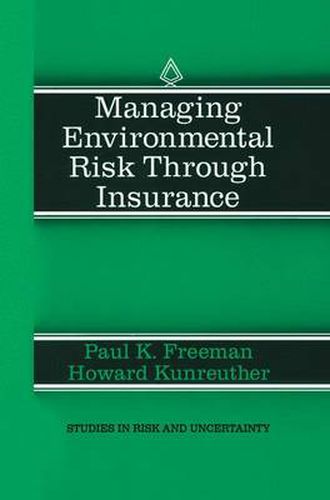Readings Newsletter
Become a Readings Member to make your shopping experience even easier.
Sign in or sign up for free!
You’re not far away from qualifying for FREE standard shipping within Australia
You’ve qualified for FREE standard shipping within Australia
The cart is loading…






This title is printed to order. This book may have been self-published. If so, we cannot guarantee the quality of the content. In the main most books will have gone through the editing process however some may not. We therefore suggest that you be aware of this before ordering this book. If in doubt check either the author or publisher’s details as we are unable to accept any returns unless they are faulty. Please contact us if you have any questions.
Can insurance be used as a means to obtain compliance with environmental policy? Answering this question requires examination of a broad mosaic of academic issues, including current systems available for providing compensation and deterrence, use of contracts (including insurance) as substitutes for tort law, limitations of regulatory policy-making by government agencies, pre-conditions for creation of insurance products, and market mechanisms necessary for insurance to be purchased or sold. The purpose of this volume is to highlight the potential role that insurance and performance standards can play in managing environmental risk. Insurance can play a significant role in dealing with one of the most problematic issues facing society today - how to compensate for environmental exposures. This text analyzes the ability of insurance to play a role in managing environmental risk. It begins by outlining the role insurance plays in society in contrast to other societal tools for addressing risk: government benefit programs and imposition of involuntary liability using the court system. By so doing, the book describes the comparative advantages of insurance. The work then analyzes the insurability of the risks. Finally, the book applies the insurability analysis to three concrete environmental examples.
$9.00 standard shipping within Australia
FREE standard shipping within Australia for orders over $100.00
Express & International shipping calculated at checkout
This title is printed to order. This book may have been self-published. If so, we cannot guarantee the quality of the content. In the main most books will have gone through the editing process however some may not. We therefore suggest that you be aware of this before ordering this book. If in doubt check either the author or publisher’s details as we are unable to accept any returns unless they are faulty. Please contact us if you have any questions.
Can insurance be used as a means to obtain compliance with environmental policy? Answering this question requires examination of a broad mosaic of academic issues, including current systems available for providing compensation and deterrence, use of contracts (including insurance) as substitutes for tort law, limitations of regulatory policy-making by government agencies, pre-conditions for creation of insurance products, and market mechanisms necessary for insurance to be purchased or sold. The purpose of this volume is to highlight the potential role that insurance and performance standards can play in managing environmental risk. Insurance can play a significant role in dealing with one of the most problematic issues facing society today - how to compensate for environmental exposures. This text analyzes the ability of insurance to play a role in managing environmental risk. It begins by outlining the role insurance plays in society in contrast to other societal tools for addressing risk: government benefit programs and imposition of involuntary liability using the court system. By so doing, the book describes the comparative advantages of insurance. The work then analyzes the insurability of the risks. Finally, the book applies the insurability analysis to three concrete environmental examples.